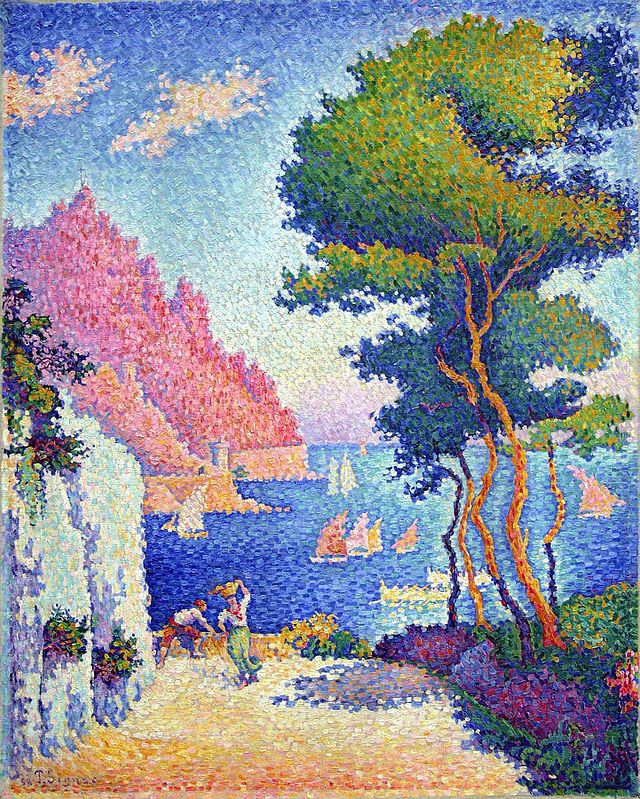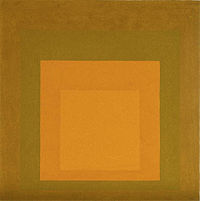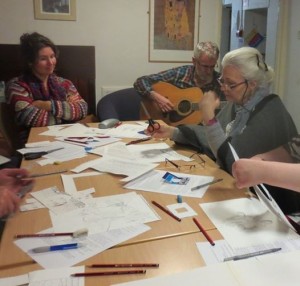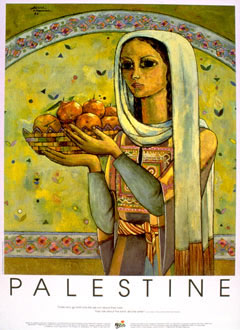This website has been entirely down, or only partially functional, for the past 5 days. This is due to a virus infection which took some time to sort out. I had to delete the website and reconstruct it from back-up, and then once it was up again there turned out to be further technical issues. These are now resolved, so the website is back! Please make full use of it, and let me know if you do encounter any further technical issues.
Category Archives: Uncategorized
Paul Signac 1863 – 1935 and Joseph Albers 1888 – 1976. Two Colour Theories
Colour is used by painters in many ways, cave painters would grind the earth around them to mix with water to create reds, ochres and browns to draw animals, Italian Renaissance painters would often depict the Virgin Mary clothed in blue, blue paint was derived from very expensive lapus lazuli to symbolise the esteem in which she is held in the Catholic Church, another symbolic colour is gold that was used by Byzantine artists. As time went by many new colour theories arose, here are two .
Pointillism. Capo di Noli Italy. 1898.
Paul Signac was born on Paris and began his career studying architecture but then changed his mind and took up painting when he was eighteen after seeing the work of Matisse, he studied the colour theory explained and used by Georges Seurat, they were two French painters who belonged to the group called Neo-Impressionists , Seurat developed the use of pure colour which he applied to his canvases in the form of dots which became known as the Pointillist style having abandoned the Impressionist method of painting with short brushstrokes, it was slow patient work, this experiment meant using scientifically juxtaposed small dots of pure colour which were intended to blend not on the canvas but on the eyes of the viewers. Signac learnt a great deal about this technique from Seurat, they became friends. Signac liked to sail around the coasts of Europe painting landscapes and making water colour paintings of French harbour scenes, the sunlight on the south coast produced sparkling seas and heightened colour. He had met Seurat and also Monet in 1884, Van Gough and Gaugin were also painting at this time. Signac was very interested in the ideas of anarchist communism but had to tone down these ideas in order to gain public acceptance.
I have chosen the painting called Capo di Noli 1898. The sparkling colours expressing the sunshine of Italy are seen in this sea – side view, whether or not you think the colours have merged to create a flat plane is left for the viewer to decide, the brush strokes of the Impressionists rather than dots of colour are perhaps more easily accepted? The shadows are in pale to dark violets set alongside the yellows of the sandy ground. Matisse experimented with pointillist painting but just for a short time.

 Homage to the Square 1965.Joseph Albers.
Homage to the Square 1965.Joseph Albers.
Joseph Albers was a German-born American artist who after studying with Johannes Itten at the Bauhaus school was asked by its founder and director Walter Gropius to join the stained glass department to teach foundation students, he also worked with Paul Klee designing glass and furniture. In 1925 the school moved to Dessau, there Albers met a student, Anni, whom he married, he worked there until in 1933 the Nazis closed the school and the artists dispersed. Albers went to live and work as a professor of art at the art school Black Mountain College in North Carolina. In 1950 he left to head the department of design at Yale University, he retired in 1958.
In 1963 he published ‘interaction in Colour’ to demonstrate his theory ‘that colours are governed by an internal and deceptive logic.’ He favoured a very disciplined approach to composition and painted hundreds of works in ‘ Homage to the Square’ in which he explored the chromatic interactions with nested squares. I remember when we students would experiment in a similar way with colour, for example we painted the same colour with a different coloured background, this showed clearly how the colour seemed to change, becoming darker or lighter, or more bright, our colour perception was changed. Albers paintings consisted of three or four squares of solid planes of colour nested within one another. These studies made very interesting viewing I think, although we see a flat surface which seemed to contain no symbols or metaphor in a left brain hemisphere way they do possess a beauty and balance that enriches our sense of colours working together. I wonder what you make of this painting. Mark Rothko painted large canvases with what looks at first like simple flat colour, but there is activity at the edges of the squares and oblong shapes he uses, the intensity and depth of colour can envelop the viewer – perhaps.
images from wikipedia.
Weekend Retreat in Sussex
Last weekend the Middle Way Society held the first of a series of three planned weekend retreats in different parts of England: this time in the village of Telscombe in the South Downs near Brighton. My feeling is that this event was a great success, with a balanced programme, a warm sense of community, and a shared sense of engagement with the Middle Way both in theory and in practice.
At first I was resistant to the society holding weekend retreats, because I felt a weekend was too short a time to sufficiently develop understanding and practice of the Middle Way – but I think I’m now thoroughly converted to the gradualist approach they suggest. They give people a chance to get a taste of the society without too much initial commitment of time or expense, and are able to attract people (e.g. parents of young children) who might find it difficult to manage a longer retreat.
One thing I’m very happy to report about this retreat was a better gender balance – indeed a slight majority of women – in contrast to the week-long retreats in 2013 and 2014 that had been decidedly male dominated. If that has something to do with it being a weekend, that provides a further argument for holding weekend retreats.
Our programme included four sessions of meditation, two talks with lots of discussion, and a drawing class with Norma Smith. Other things that happened without needing to be programmed were a walk on the downs and an impromptu singing session led by Barry on his guitar (pictured). Despite some minor setbacks (traffic delays on arrival, a certain amount of rain and a lost lemon), a friendly atmosphere quickly developed.
The theme of the retreat was meaning, which I introduced with talks relating embodied meaning to the Middle Way, to religion and to the arts. There were quite a few interruptions, but I was rather pleased by those, as they showed people constantly engaging with the concepts and relating them to their own experience. I expected that all I could offer in terms of ideas on a weekend was an initial stimulus rather than in-depth study, but I think it fulfilled that role. The drawing class also allowed us to experience a predominantly right-hemisphere, embodied meaning as we tried to draw a still life arrangement set up by Norma.
Many thanks to Norma for the class, as well as Nina for provisioning and Barry for dealing with the finances – and indeed everyone else, who all contributed to the retreat in their own way. Our next weekend retreat is in Yorkshire on Feb 20th-22nd 2015 (see link for details), focusing on the environment, and there is another one in Worcestershire on 5th-7th June 2015, focusing on meditation (see link). Hope to see you there!
Picture taken by Norma Smith
Refugees – our responsibility?
The UK Foreign Office stirred ire in Brussels on Tuesday when it announced that it would not participate in any future search and rescue operations, because of their “pulling factor” in encouraging economic migrants to set sail for Europe. An estimated 2,500 people are known to have died this year while making the perilous trip across the Mediterranean Sea.
Is he right? And what might those options be? Or is his hard-headed pragmatism beyond the pale?
Sliman Mansour 1947 – Palestinian Artist. Salma, a Poster 1988
Sliman Mansour was born in Birzeit, Jerusalem in 1947, he went to a boarding school in Bethlehem. He is a painter, sculptor, writer and teacher, he played a part in the Liberation Art Movement in Palestine and was one of the New Visions group of Palestinians, he also served as the head of the League of Palestinian Artists from 1986 to 1990 and served as a director of the Al-Waihi Art Centre in Jerusalem, he organised exhibitions from 1990, his work is exhibited in Palestine, Israel, across Europe, Norway and America, he has written two books on Palestinian folklore and in 1998 he won grand prize at the Cairo Biennial. His work is aimed at reminding the Palestinian community of their roots and identity since territory was occupied by Israeli forces. The history of Palestine is far from simple, in the 18th. Century the population of Palestine was 250,000, 6,500 of them were Jews, by 1897 there were three times as many inhabitants, the majority were Gentiles and more than half a million were Arabs.
Mansour started experimenting with mixed media, such as mud, henna, lime on wood and assemblage materials, the idea behind their use was to use home produced materials and boycott paints from Israel. Mansour was working towards giving Palestinians their identity back while still being ruled by Israeli governments, the second intifada saw the death of 3,000 Palestinians and 1,000 Israelis which ended with the PM Ariel Sharon and President Mahmoud Abbas committed to keep the peace in ‘Roadmap for Peace’. Mansour said ‘art helped and is still helping a kind of revival of Palestinian identity. And through art we helped in creating that…. creating symbols for Palestinian identity through art.’
I have chosen a poster, probably painted in water colour of a young Palestinian women called Salma, dated 1978, she wears traditional embroidered clothing, she holds a bowl of oranges, the fruits of the land with her labourer’s hands, the orange tree is a symbol of ‘catastrophe,’ – the occupation of Palestine, more about that later. Mansour is among the intifada group of artists who follow a third way of non – violence, ‘not succumbing to occupation nor getting overwhelmed by hate in confronting the occupation, keeping dignity in everyday life, connecting to the land, culture, religious rights and identity and having respect for the other’s source of identity,’ they were concerned too with Moslem- Christian relations.
Background to the conflict – with reference to a recent review I read in the London Review of Books by Nathan Thrall called My Promised Land; The Triumph and Tragedy of Israel by Ari Savit, the grandson of Herbert Bentwich who in 1897 sailed to Jaffa with a delegation of twenty one Zionists to investigate whether Palestine would make a suitable site for a Jewish national home. Bentwich shut out the fact that non Jews were already living there, he failed to notice the Arabs and Gentiles only planning a Palestinian land for Jews, soon 25,000 mainly secular Jews moved into Palestine and lived in communal agrarian settlements. By 1935 a quarter of the population was Jewish, in 1936 to 1939 there was the Arab Revolt against the British Mandate and Jewish immigration, ethnic conflict had become almost inevitable. In May 1948 Arab armies invaded the territory called Lydda, any rebellion was crushed by the Israeli forces, called the ‘ Catastrophe,’ tensions still exist. The UN idea to divide the land was rejected by the Arabs and fifty six per cent of the land was given to the Jewish population. Sliman Mansour was part of the second intifada working towards a resolution to the conflict. Shavit wrote ‘ that if Zionism was to be then Lydda could not be’ which perhaps condones the actions taken. Although ‘ Ben Gurion was enlightened,’ his wishes to resolve the conflict did not last long.
Mansour painted a series village paintings to remember those inhabitants uprooted in the Jezreel Valley to provide new homes for Israelis. Mansour’s work was often seen as subversive by the Israeli government, he spent time in prison. Art critics see his work as possessing great maturity which shows an awareness of international currents in art. In other posters by Mansour like Salma we see a young woman in traditional dress, often the female image is used for the mobilisation for Palestinian Resistance filled with ‘complex meanings of nation, rootedness, resistance, fecundity and Palestine itself.’ Another poster called The Camel of Heavy Burdens, 1980, the camel depicted is an iconic description of a camel which goes on giving milk in times of drought.
On Youtube there is a clip showing Mansour’s work with music called Baghranni (I sing) sung by Amal Markos.

